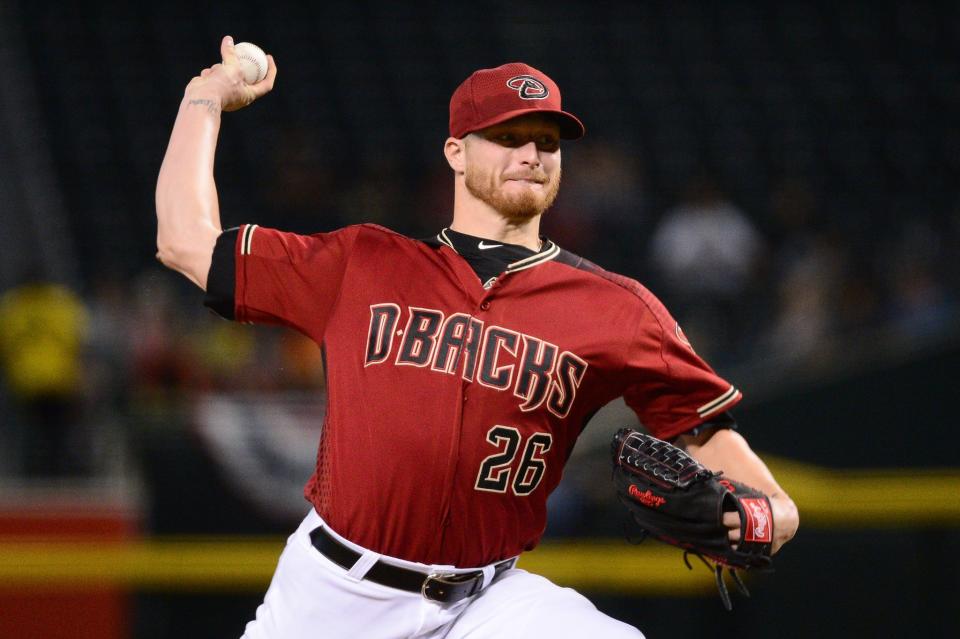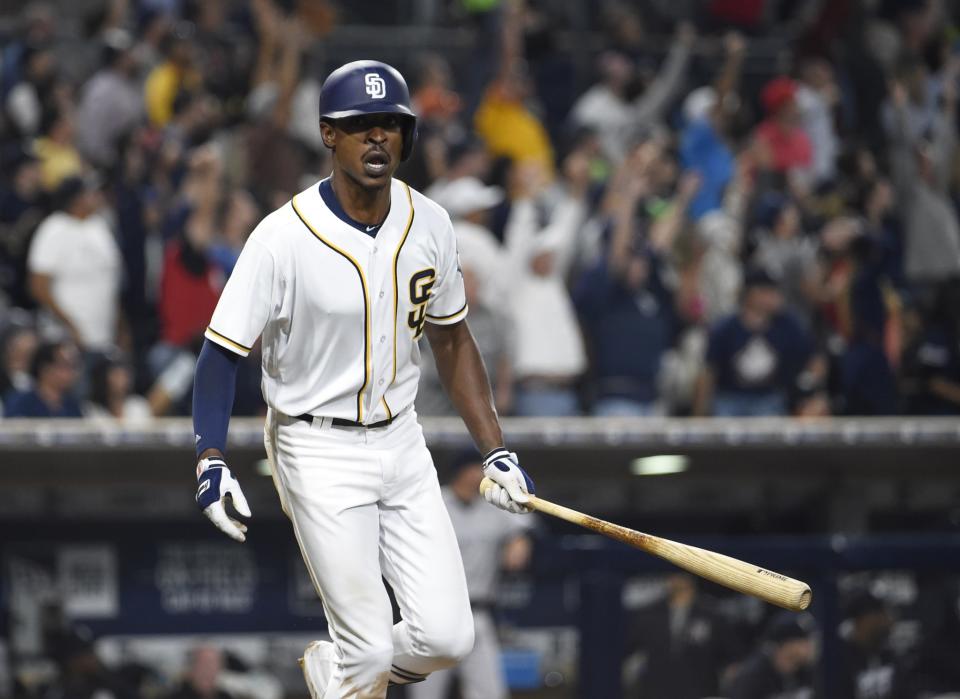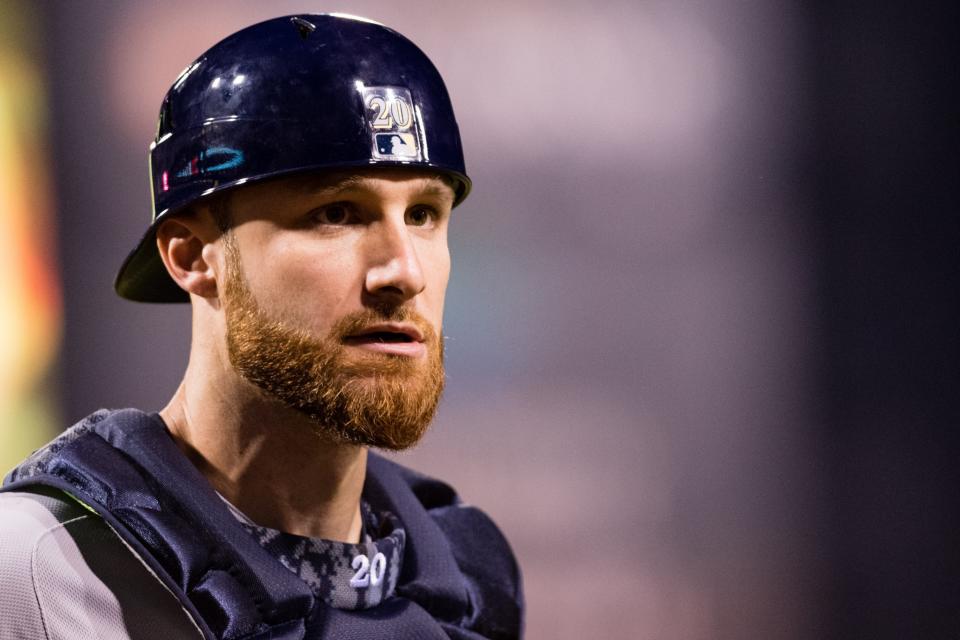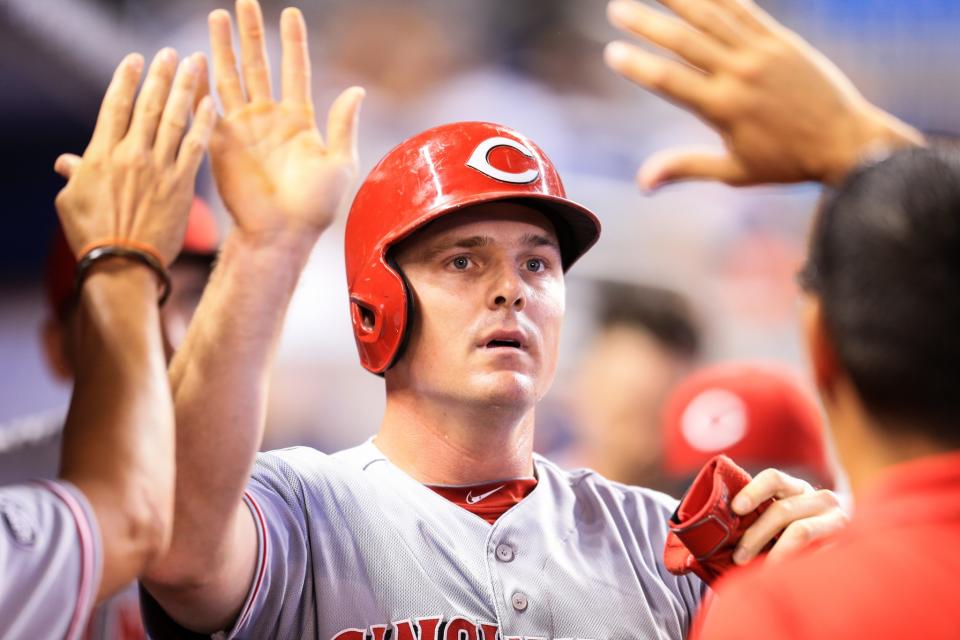Why closer Aroldis Chapman is valuable and other trade info
One week out from the trade deadline, and a full one-third of the teams in Major League Baseball are playing at least at a .550 clip this year. Only one, in the meantime, is over .600. Which means a big, muddled, confused pile of contenders, all of whom have every right to believe this year may be the year and spend their days until Aug. 1 acting accordingly.

The Chicago Cubs are making the first spirited push, acquiring Aroldis Chapman from the New York Yankees and offering 19-year-old Gleyber Torres, arguably their best prospect, in addition to two other players, league sources told Yahoo Sports. Chapman pitches only one inning at a time, and Chapman is a free agent come the end of the season, and Chapman’s history includes an ugly domestic incident, and still, the Cubs are willing to pay a price rival executives see as excessive.
Why? Because they’re the aforementioned team winning more than 60 percent of its games. Because they’re the only could-be alpha dog among a bunch of betas. Because they need relief help. Because Kris Bryant and Anthony Rizzo. Because they spent years rebuilding their farm system and now are in a position to use its capital on luxury items. Because they believe Joe Maddon can integrate even the worst reprobates into his clubhouse. And, mostly, because …
1. Aroldis Chapman throws 105 freaking miles per hour, and only one other pitcher in the world, a 20-year-old Red Sox prospect named Michael Kopech, ever has reached that level – and Kopech’s was on radar guns, not a computerized pitch-tracking system that measures to the tenth of an mph.
Yes, Chapman is, all due respect to Zach Britton and Kenley Jansen, the single most dominating force at the back end of a bullpen in 2016. His average fastball this season is 100.1 mph. Of the 524 pitches tracked by Statcast this season, 254 were 100-mph-plus fastballs. He is a freak of nature, and freaks of nature are valued more for their freakishness than they are dinged for their issues.
And make no mistake: The notion the Cubs are trading for a player suspended for 30 days earlier this season for bucking off gunshots in his garage and allegedly assaulting his girlfriend is off-putting. No charges were filed. That doesn’t lessen the stigma that accompanies domestic violence and the tacit admission that championships sometimes cost more than money or prospects capital.
The Cubs get to deploy Carl Edwards Jr. or Pedro Strop in the seventh inning, current closer Hector Rondon in the eighth and Chapman in the ninth, with Travis Wood, the recently acquired Mike Montgomery and Trevor Cahill or perhaps even the resurgent Joe Nathan rounding out what suddenly looks more like a strength. Even better, the Cubs’ acquisition of Chapman could start a frenzy on …

2. Wade Davis should the Kansas City Royals move beyond exploratory discussions about their closer, who the last two seasons was the best in the game but this season sports a 1.10 ERA, not entirely indicative of his performance. Davis has been excellent; he just hasn’t been Wade Davis, robot closer.
The Royals are valuing him that way, according to sources. In one internal conversation, Kansas City was discussing possible destinations for Davis and considered the Washington Nationals, whose desire for a closer to replace Jonathan Papelbon would grow even stronger if they couldn’t get Chapman. With Davis under contract the rest of this season and for just $10 million next season, the Royals bandied about a potential target, according to sources: Lucas Giolito.
As in, arguably the best pitching prospect in baseball. If the Yankees are on the verge of getting a near-top 25 guy in Torres, plus more, for a maximum of three months’ action, a request for Giolito isn’t that crazy, right?
Eh. It’s pretty close to the deep end. And unless over the next week the Royals’ price drops, Davis will stay in their uniform until 2017. Which is probably how it ought be. Smart teams right now are doing their best to gauge the market on their players, whether it’s to gain intel on potential future trade partners or extract a possible godfather deal. Had Arizona not pined for …

3. Shelby Miller, Atlanta wouldn’t have Dansby Swanson in its minor league system at the moment. The Braves do have the 2015 No. 1 overall pick, though, and now the Diamondbacks are prepared to admit the monumental error of that deal by offering Miller to teams in a trade, league sources told Yahoo Sports.
Even if Miller were pitching well this season, the acquisition cost of Swanson, outfielder Ender Inciarte and pitching prospect Aaron Blair would be prohibitive. Miller has been nothing short of disastrous this season, allowing 122 baserunners in 69 1/3 innings, sporting a 7.14 ERA and, at the moment, biding his time in Triple-A while Arizona’s nightmare season at the big league level continues to slog onward.
The Diamondbacks are open for business, a yard sale ripe for the picking, and once the carcass is plucked, they’ll still have a core of Paul Goldschmidt, Jake Lamb, A.J. Pollock, Zack Greinke, Patrick Corbin and Robbie Ray, which isn’t the worst place to start. It’s not ideal, either, and the idea of a full-fledged rebuild might not be a bad play were it another team. These are the Diamondbacks, though, and they’re experts at self-immolation, and the prospect of giving the current management the keys to oversee an overhaul simply shouldn’t happen.
In similar limbo are the Chicago White Sox, which makes the decision on …

4. Chris Sale even more difficult. When the White Sox started listening to offers on Sale – this was before he gutted their throwback jerseys – they did so because closed-mindedness in a seller’s market is for fools only. You shop. You listen. You move forward if a proper offer presents itself.
Here’s what makes Sale particularly attractive to buyers: His price isn’t going down, not for a good long while. Should a team pick up both of his club options, nearly 3½ years remain on Sale’s contract at a total of about $43 million. It is one of the game’s friendliest contracts. The White Sox, then, are going to ask for a giant haul of prospects whether it’s this summer, this winter, next summer, next winter or even the summer and winter of 2018. Trade value doesn’t wobble much this far out from free agency, and yet players like Sale are so infrequently traded in their prime that the deal White Sox GM Rick Hahn is seeking makes sense.
If the Red Sox want Sale, the deal starts with Yoan Moncada or Andrew Benintendi (whom the White Sox wanted in last year’s draft before the Red Sox sniped him a pick before). If the Dodgers want Sale, the deal starts with Julio Urias. If the Rangers want Sale, the deal starts with Nomar Mazara. If the Astros want Sale, the deal starts with Alex Bregman. Most teams don’t have someone to build a trade around.
Maybe one of them says OK, then tosses in three or four other top young players to boot. The fact that Sale is the only bona fide dude available – the impact arm so many contenders want and need – puts Hahn in a position of power. Granted, it’s one Sale himself lessened through the jersey cutting as well as his outburst against White Sox president Kenny Williams during spring training.
No matter how great Sale is – and he’s great – the incidents have lent credence to the inmates-running-the-asylum vibe that emanates from the White Sox. The incident didn’t hurt his trade value in that anyone cares what he did to a jersey. It’s the sort of thing that forces Hahn and the rest of the White Sox to think, though, whether they really do want to keep Sale or instead do a little bait and switch with …

5. Jose Quintana being the guy who goes somewhere. Quintana is one of the most underrated pitchers in baseball, a 27-year-old left-hander owed just $40 million through 2020. One could argue it’s every bit as good a deal as Sale’s, and the White Sox are treating it accordingly.
One source said the price on Quintana is nearly as high as that on Sale. Another characterized it thusly: “They’re treating him like a [No.] 1.” Quintana’s track record doesn’t sparkle quite like Sale’s, but considering the options on the starting-pitching market, not to mention that a week of haggling remains, the White Sox’s tack with their pitchers is proper.
If not Sale or Quintana, who? Jeremy Hellickson? Andrew Cashner? Edinson Volquez? Ervin Santana? With Rich Hill’s blister slowing up his market, the Rays asking for the moon on Jake Odorizzi and Matt Moore, the prospects of Julio Teheran and Anthony DeSclafani being dealt unlikely, and the rest of the candidates underwhelming, it’s how a guy like …
6. Wade Miley ends up available to the right team. The Mariners have quietly shopped Miley despite sporting a record two games above .500, according to sources. Seattle isn’t clearly selling; it could just be seeking a new home to park Miley and his 5.23 ERA, a disappointment after arriving from Boston in a deal for reliever Carson Smith, who later blew out his elbow.
Miley, 29, is on his third team in three seasons and has carved out a niche as a reliable innings eater. Those innings haven’t been particularly good over the last three seasons, but there is comfort in consistency, and teams have grown familiar with Miley making a start every turn in the rotation.
It’s cases like that of …

7. Melvin Upton Jr. that confuse scouts and executives. Following the first two years of his five-year deal with Atlanta, during which Upton hit a combined .198/.279/.314, his $72.25 million deal looked like one of the worst busts ever. The Braves dumped him on San Diego, figuring three seasons of dead money. Then Upton put up a 111 OPS+ last season and has chased it by hitting more home runs this season than any time since his final season in Tampa.
So, yeah, there’s a market, and the safe money at this point is that he ends up in Baltimore as a corner outfielder and insurance in case of an Adam Jones injury in center. If Ubaldo Jimenez is indeed the centerpiece going back to San Diego, the Orioles will need to pay prospect capital seeing as Jimenez’s contract is nearly equivalent to Upton’s and San Diego would be doing Baltimore an enormous favor taking it on.
Remember: The Orioles once gave a draft pick to the Dodgers simply for taking on Ryan Webb’s $2.8 million deal and did the same again this year with Brian Matusz’s contract. In Upton, they would be getting a significant value swing for the money they’re spending, and that wouldn’t come cheap. Rebuilding GMs need to be as value conscious as possible, whether it’s A.J. Preller trying to deal Upton and Cashner and catcher Derek Norris or Brewers GM David Stearns figuring out where …

8. Jonathan Lucroy ends up. In a trade deadline purported not to have a star before Sale became available, Lucroy was the sneaky, wildly underrated favorite of both scouts and sabermetricians. Among catchers, only Wilson Ramos has put up a better line than Lucroy’s .301/.362/.491, and Lucroy remains considered one of the best, if not the best, defensive catcher in the National League.
The frenzy is only exacerbated by Lucroy’s contract, which will cost less than $7.5 million for the rest of this season and all of 2017. Cleveland is hot after him. The New York Mets have shown interest. The Rangers have long yearned for Lucroy. And the Brewers don’t necessarily have to deal him. They can hold on until this offseason, when the awful free agent class of 2016-17 hits and reminds everyone impact players are far likelier to be found on the trade market.
Holding onto a player always poses a risk – see: Gray, Sonny – but teams can be rewarded not for selling a player at his nadir, as …

9. Jay Bruce proved with the Cincinnati Reds. Bruce has continued to hit since the All-Star break, thumping three home runs and raising his slugging percentage to .547, 10th in the National League. Now it’s a matter of figuring out where he goes, because if Cincinnati doesn’t deal him this week, it could run the risk of holding on too long to an appreciated asset.
The Dodgers have discussed Bruce with the Reds, and they find themselves in perhaps the most interesting position of all the contending teams: knowing they’re good but wondering exactly how good. The Dodgers are 12 games over .500 and just three back of the San Francisco Giants. Their run differential is better than the Giants’, too, and despite an NL West with launching pads in Colorado and Arizona, their 371 runs allowed are nearly best in the league.
Of course, plenty of that is due to Clayton Kershaw, and there is the true complication: Trying to figure out how far the Dodgers can go without Kershaw, whose back injury still has no timetable for a return. The Dodgers should be getting Brett Anderson back soon. Brandon McCarthy has been brilliant, Kenta Maeda solid, Scott Kazmir consistently OK and Bud Norris at least a halfway decent version of Bud Norris. Is that enough to win? Perhaps, though enough to win shouldn’t exactly be the threshold for a quarter-billion-dollar team.
Dodgers president Andrew Friedman faces some rough decisions over the next week. Remember, he could’ve been the one with the …
10. Aroldis Chapman problem until he nixed a trade at the Winter Meetings after the police report on the domestic incident surfaced. Eight months ago, Aroldis Chapman was completely toxic. And whether it’s to the Cubs or elsewhere, the Yankees are going to get paid handsomely for offloading Chapman.
Of the four young players Cincinnati received, only pitcher Rookie Davis is expected to have a shot at sticking in the major leagues – and even he’s striking out just 5.1 batters per nine in Double-A this year, a major red flag. Essentially, the Reds gave away Aroldis Chapman, and the Yankees got a top prospect still in his teen years, plus other pieces, for the same guy.
Baseball is the same as all other sports, willing to look past any moral or ethical conflict so long as on-field performance doesn’t wane. And that is how Aroldis Chapman and his powerful 105-mph fastball will end up wearing something other than pinstripes. He is just what the Cubs need, just what the Nationals need, just what the Indians need, just what everyone needs. And when the muddled middle is so crowded and anyone can win a World Series, the power of the need, no matter what may stand in its way, is the most powerful thing of all.

 Yahoo Sports
Yahoo Sports 
